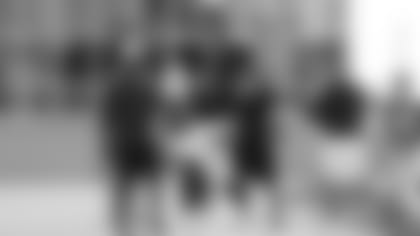ENGLEWOOD, Colo. --If your defense attacks quarterbacks with the speed and frequency of the Broncos, you're going to have some collisions. And given the difficulty of adjusting one's trajectory at full speed with little room before contact, sometimes helmets are going to be involved.
But there's a difference between being having those types of plays and being a "dirty" team. That implies not merely a desire to stop an opponent with the context of the game, but to injure and harm beyond it.
And that word understandably rankles the Broncos.
"I disagree with it," Head Coach Gary Kubiak said. "We play hard. We're going to continue to play hard."
"I just don't think that's what we are," added inside linebacker Todd Davis. "We're not malicious. We don't intentionally go to hurt anybody. We just play hard. We play physical and we play hard. I don't believe we're malicious or a dirty defense at all."
Inside linebacker Brandon Marshall knows he could face a fine from the league for a helmet-to-helmet collision with Carolina's Cam Newton last Thursday that did not draw a penalty. But he knows what dirty play is like -- and he asserted that his play was not anything of the sort.
"'Dirty' is intentional," Marshall said, recounting a story from his University of Nevada days as an example.
"One time, I was in college, and I made a tackle, and there's a pile," he remembered. "I saw a player from Utah State run around the pile -- and I'm on the ground still -- he ran around, he grabbed my ankle, he twisted it and stepped on it. That's dirty. You know what I'm saying? Stuff like that. We don't do stuff like that."
The perception of dirty play comes from helmet-to-helmet collisions that for decades were a standard part of the game, but in recent years have been targeted for elimination via myriad rules changes in an attempt to improve player safety. The frequency of those types of impacts has dropped, and the punishment for those plays has increased. But given the nature of the sport, complete eradication of suchhits is a virtual impossibility.
Further, defenses face a conundrum, particularly when it comes to the era of super-sized quarterbacks. If defenders can't hit high and can't go low, they're left with trying to tackle the players' chest and midsection -- and increasing the risk of simply bouncing off the quarterback.
Quarterbacks haven't gotten taller over the years; the average height of today's starting quarterbacks is 6-foot-3.16 inches, which is actually 0.09 inches shorter than the average of the primary starters in 1990. But they have gotten bigger and stronger; the 1990 starters weighed an average of 209.6 pounds; today's starters average 224.8 pounds, a 15.2-pound increase.
The heaviest starting quarterback in 1990 was Mark Rypien, who at 234 pounds was considered relatively immobile; he had a career total of 166 rushing yards on 127 attempts in 12 pro seasons. Today, eight quarterbacks are at least 234 pounds, including the 250-pound Newton and the 234-pound Andrew Luck, both of whom are considered among the game's best quarterbacks on the ground.
If you stop and square up on these quarterbacks, they can run around you. If you don't hit in the right spot, you are penalized.
"Absolutely," said Marshall. "And I feel for [Darian] Stewart and them safeties. Those guys are 200 pounds, 210 pounds, so when they get a 250-pound guy running at them, they're going to either hit them high or low," Marshall said. "They're going to get them down any way they can.
"[Cam] is bigger than all of our linebackers."
And it takes extreme awareness and proper positioning to bring him down.
"We just play hard, man," Marshall said. "We hit hard. We play fast. We play faster than any defense in the league, in my opinion. So just because we hit Cam in the head a couple of times, that doesn't make us dirty.
"Look at some of the dirty players in the league -- there are a lot of dirty players. And that's not our m.o."















